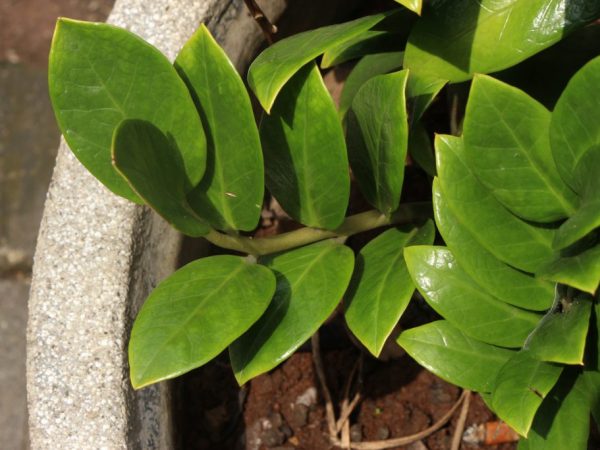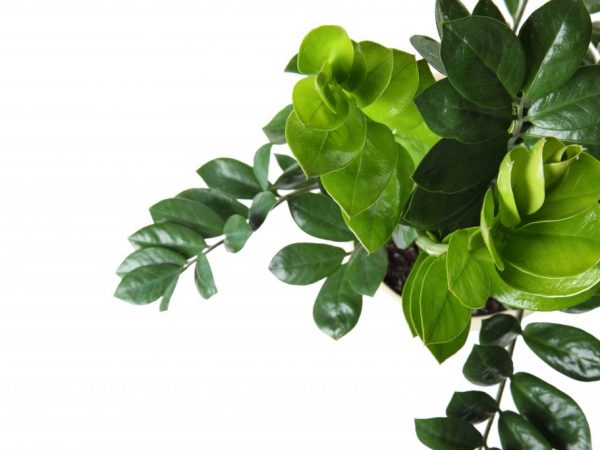Watering Zamioculcas - rules and recommendations
Proper watering of Zamioculcas is the key to its beauty and health. This flower comes from the hot African continent, so it tolerates dryness better than excess moisture. To grow successfully, you need to balance and take into account the season, moisturizing the plant as needed.

Watering Zamioculcas - rules and recommendations
Basic Rules
Frequency
The frequency of watering Zamioculcas at home can only be roughly indicated, because much depends on the season and the characteristics of the succulent.
The roots of a plant are tubers that store moisture for a long time, which allows them to successfully tolerate temporary drought.
But excess moisture affects them negatively, causing rot and, as a result, the death of the flower. Therefore, flower growers are guided by a universal rule: it is better not to top up than to pour.
The timing is determined by the condition of the soil - it should dry well, but not completely. It is necessary to check not only the upper layers of the substrate, but the contents of the pot up to about half. To do this, stick a thin wooden stick into the ground.
You can water the plant from above or through a tray, but it is better - according to a combined scheme.
Some flower growers use special flowerpots with auto-irrigation, but in general, the attitude towards them is ambiguous.
Water requirements
Watering is carried out with soft, settled water. The minimum settling period is a day. The temperature of the liquid is room temperature, in winter it is slightly warm. If possible, it is better to use rain or spring water.
Irrigation technology
- The flower is watered from above, strictly under the root, using a watering can with a narrow spout. With this moisture, it is impossible to get on the leaves of the plant.
- The substrate in the flowerpot should be loose and well-drained, so the water will quickly pass through the soil and fill the sump. In this position, it should be left for 15 minutes.
- With the winter procedure, the leftovers are simply drained after 15 minutes, with the summer procedure, they are poured into the pot again, and when the water flows into the lower container, they are immediately poured out.
Top dressing
An important part of caring for a home flower is regular feeding, which is combined with watering. In spring and summer, Zamioculcas is fed with a universal complex for succulents. Fertilizers are applied every two weeks.
The nutrient solution is poured in the second stage after preliminary moistening of the substrate. Florists advise to halve the portion indicated on the package in order to be safe from root burns. In addition, once a month, you can carry out a foliar procedure by spraying the leaves with urea.
Features of the procedure
After transplant
There is a rule - Zamioculcas should not be watered after transplanting. However, a lot depends on the substrate into which the succulent is transplanted.
If the soil mixture is completely dry, watering is done during the transplanting process.And the next one - only after 7-10 days, making sure with a stick that the earth is dry enough.
If the transplant is carried out in moist soil, the flower is not watered. After 3-4 days, Zamioculcas is carefully moistened and the water is immediately drained from the tray. At the same time, they are guided by the state of the substrate: if there is no complete certainty, it is better to postpone the procedure for another day.
In summer

Watering is carried out as the soil dries out
In the warm season, moisture from the soil evaporates quickly, so watering is carried out more often. Starting in spring, the frequency of procedures gradually increases: first, once every two weeks, and then every 10-7 days. In this case, the condition of the soil must be checked with a stick, taking into account the real needs of Zamioculcas.
In a very hot summer, you can water more often, provided that the substrate dries out to half the pot. Atmospheric humidity is not very important for the plant itself, but it does affect the rate of evaporation from the ground. So, in dry air, the upper layer dries quickly, while the lower one is still wet. In this case, it is impossible to focus on superficial dryness - additional watering will lead to waterlogging of the roots and the risk of disease. In order not to get confused, it is better to keep the humidity in the room within normal limits.
In winter
Starting in autumn, the number of procedures has been gradually reduced. During the period of winter dormancy, they are carried out every 3-5 weeks. At the same time, they still check the condition of the soil with a stick.
In cold weather, water temperature becomes an important condition. It should not be too warm, but slightly above room temperature. Top dressing is not carried out in the autumn-winter months. Heating devices can provoke excessive dryness in the room, therefore, the humidity should be monitored. It is recommended to humidify the air from the atomizer and make ventilation, but not to expose Zamioculcas to the danger of drafts.
Excess moisture
Waterlogging of the soil negatively affects the health of the flower and can lead to its death.
The main danger is root rot: light red spots appear on the leaves, the stems darken, soften and become thinner; the plant wilts and slows down in growth. But these are only outward signs of the main problem - root rot.
Home treatment
At the first signs of illness, water procedures should be stopped immediately. It is better to transplant the plant by removing damaged leaves and rotten parts of the roots.
Before transplanting into a new substrate, they are cleaned and treated with fungicides. You can water the flower only after the soil has thoroughly dried out.
Lack of moisture
Zamioculcas does not react so painfully to a lack of moisture, but in this case it does not do without consequences. When the substrate dries up and the water supply in the tubers is depleted, the plant begins to dry out.
The drying process goes from the top, and not from the roots, so when resuming leaving, the flower can be fully rehabilitated.
Symptoms of the problem are yellowing, drying and dropping of the upper leaves. And of course dry potted soil. At the first signs of a lack of moisture, you need to revise the regime. Water Zamioculcas more often and more abundantly (but do not overdo it) and its health will gradually recover.

